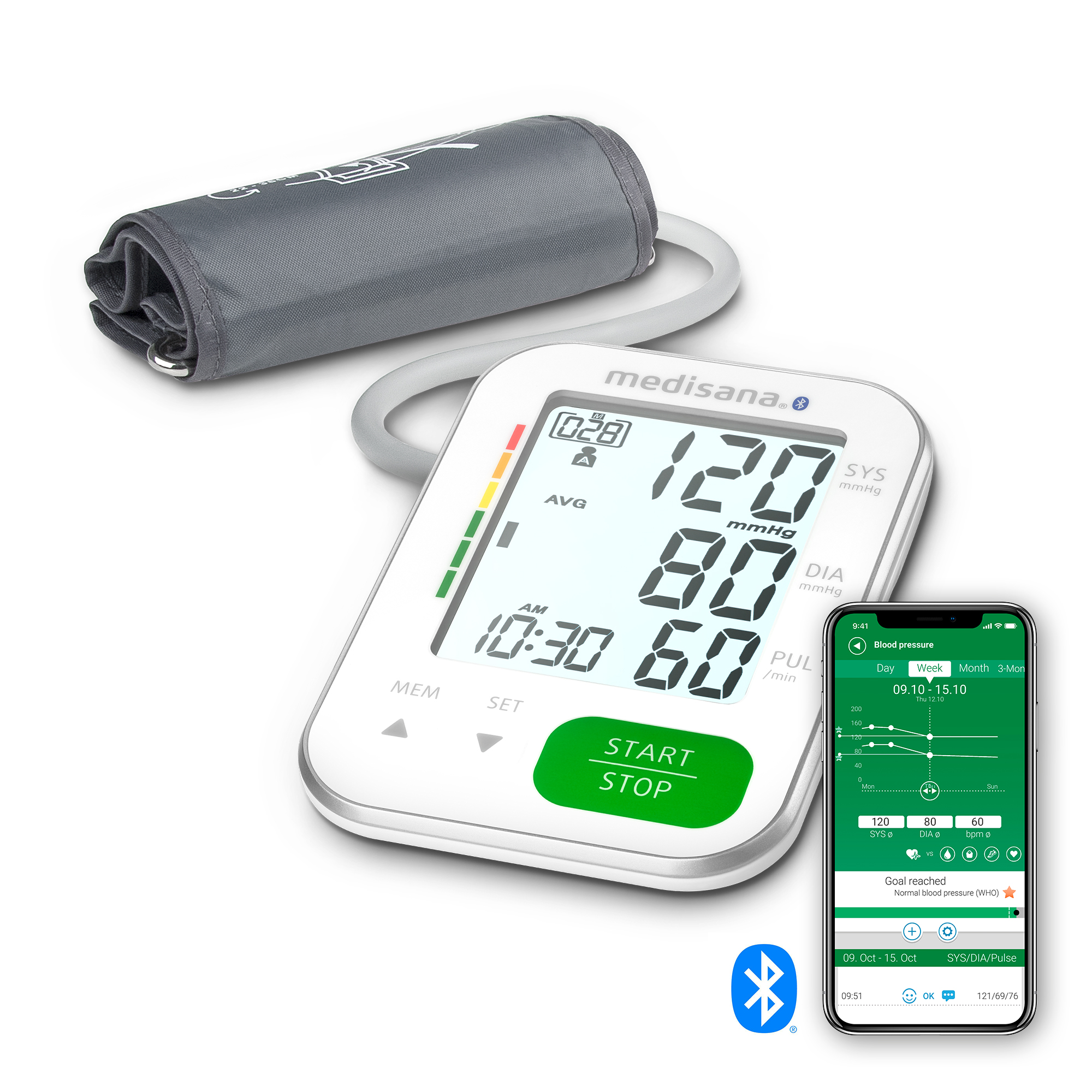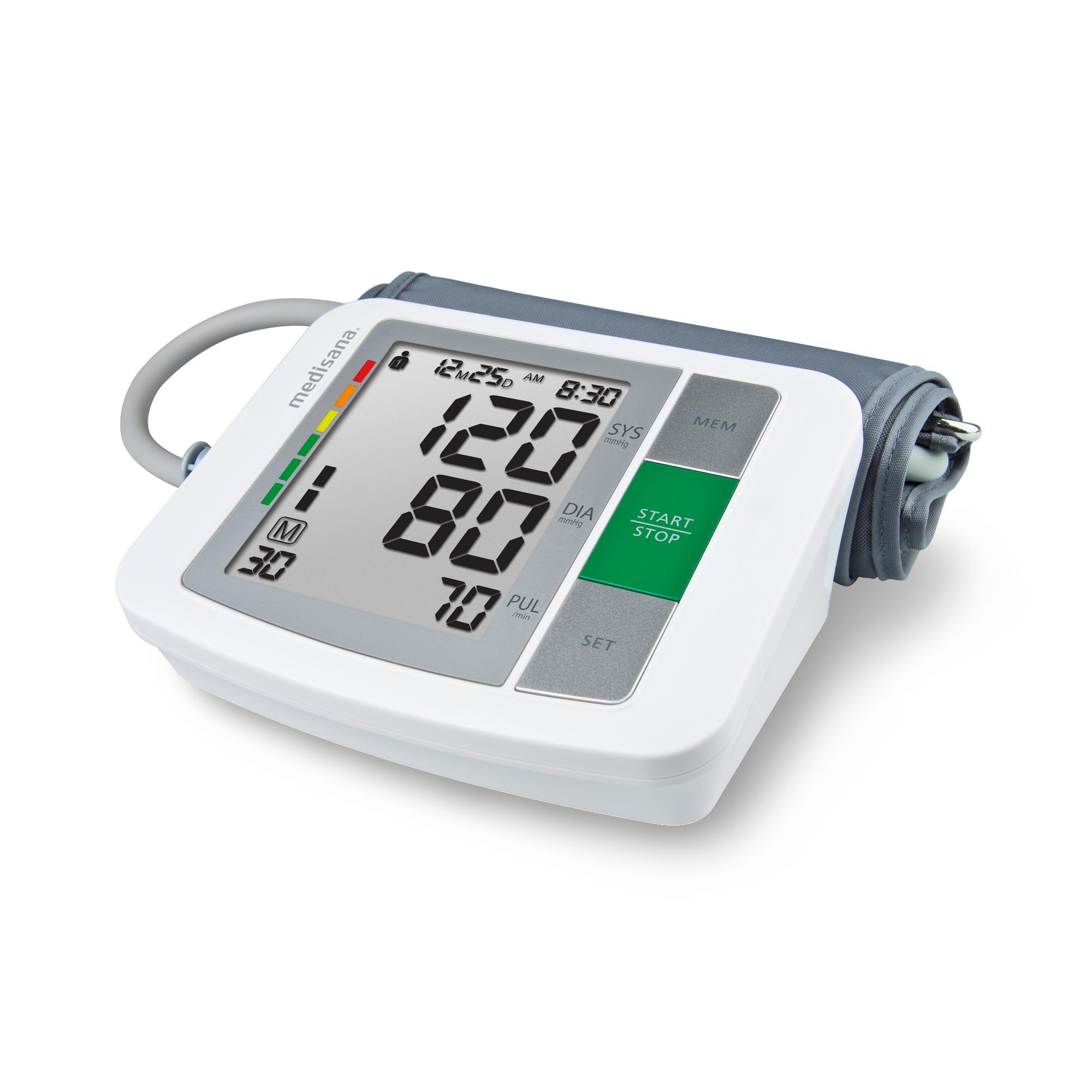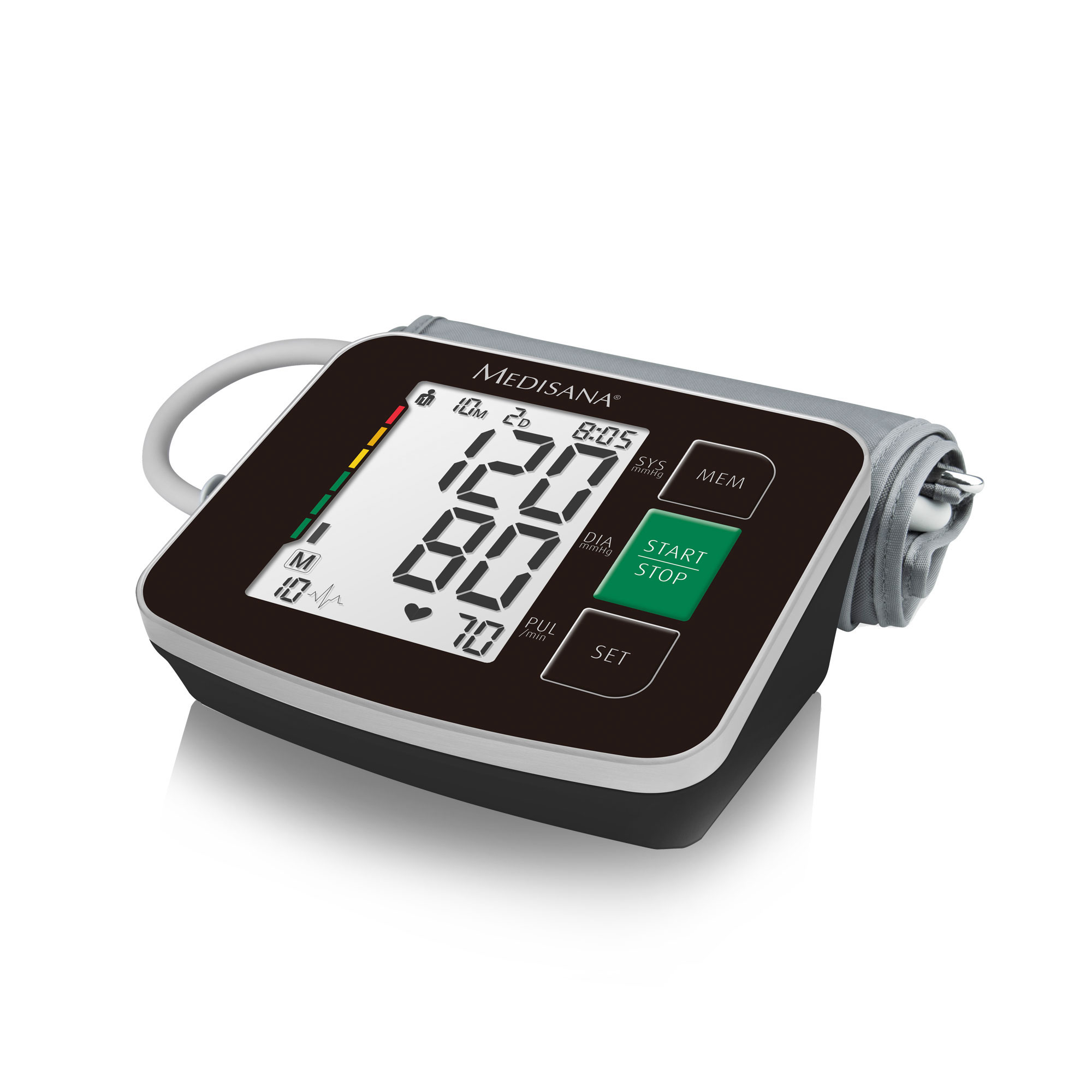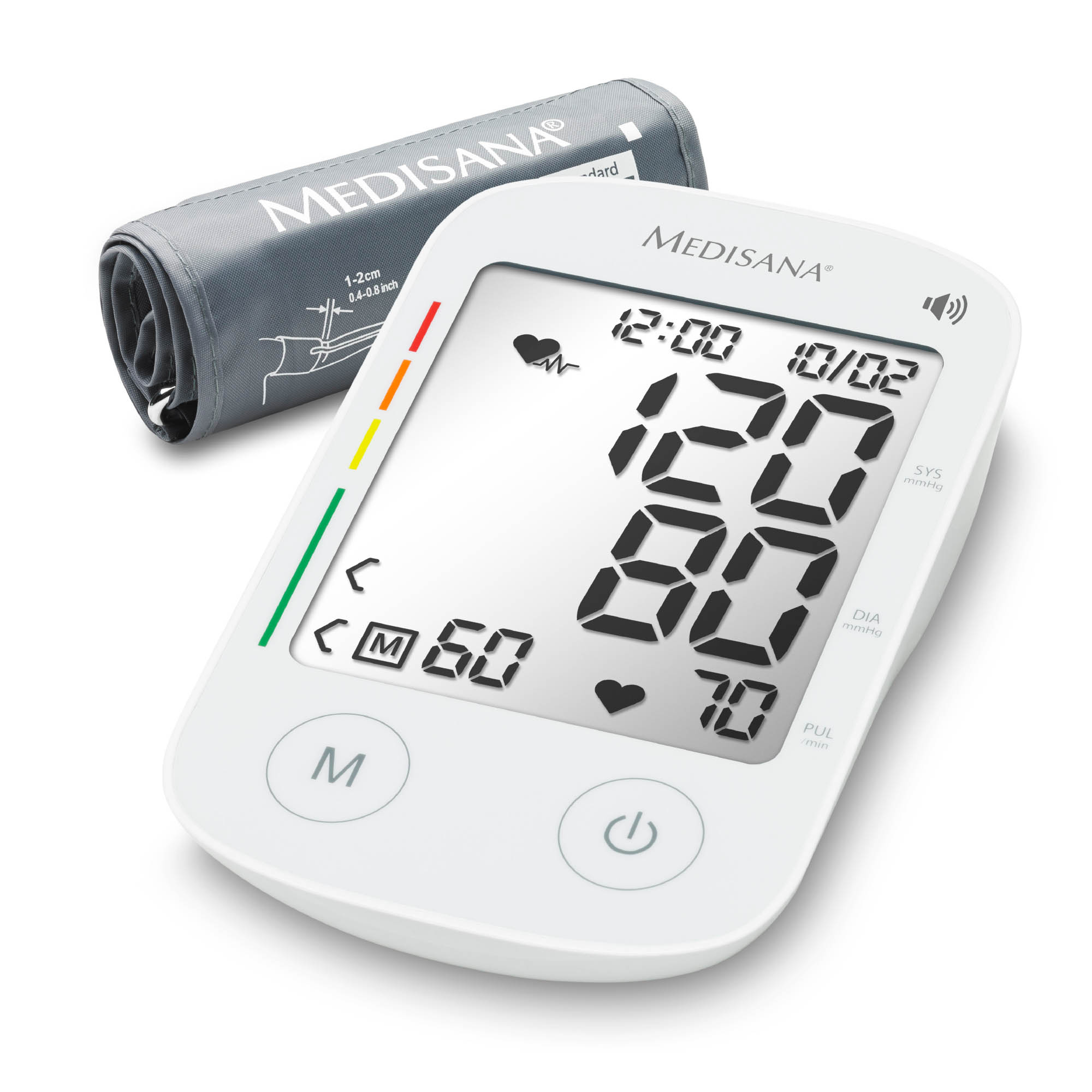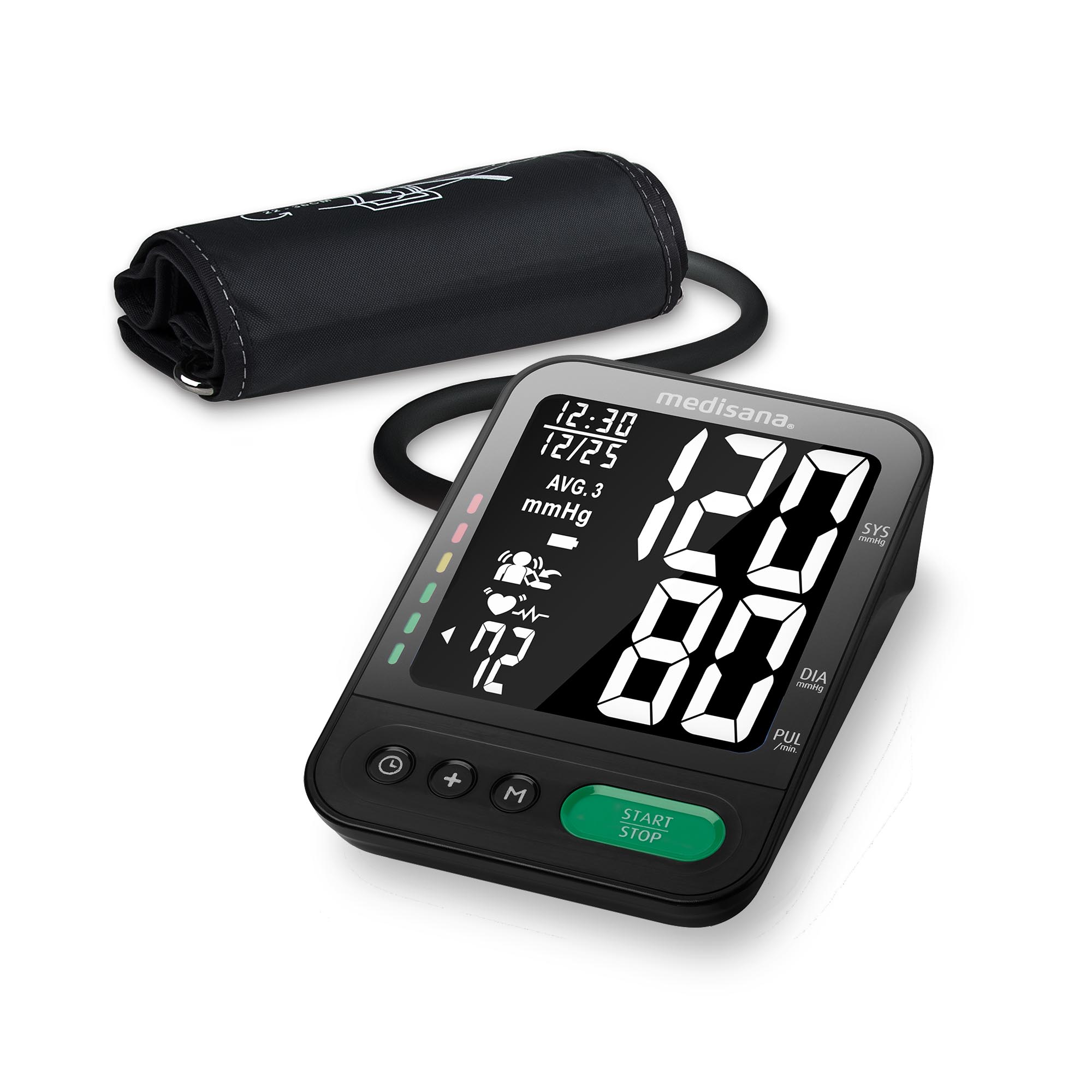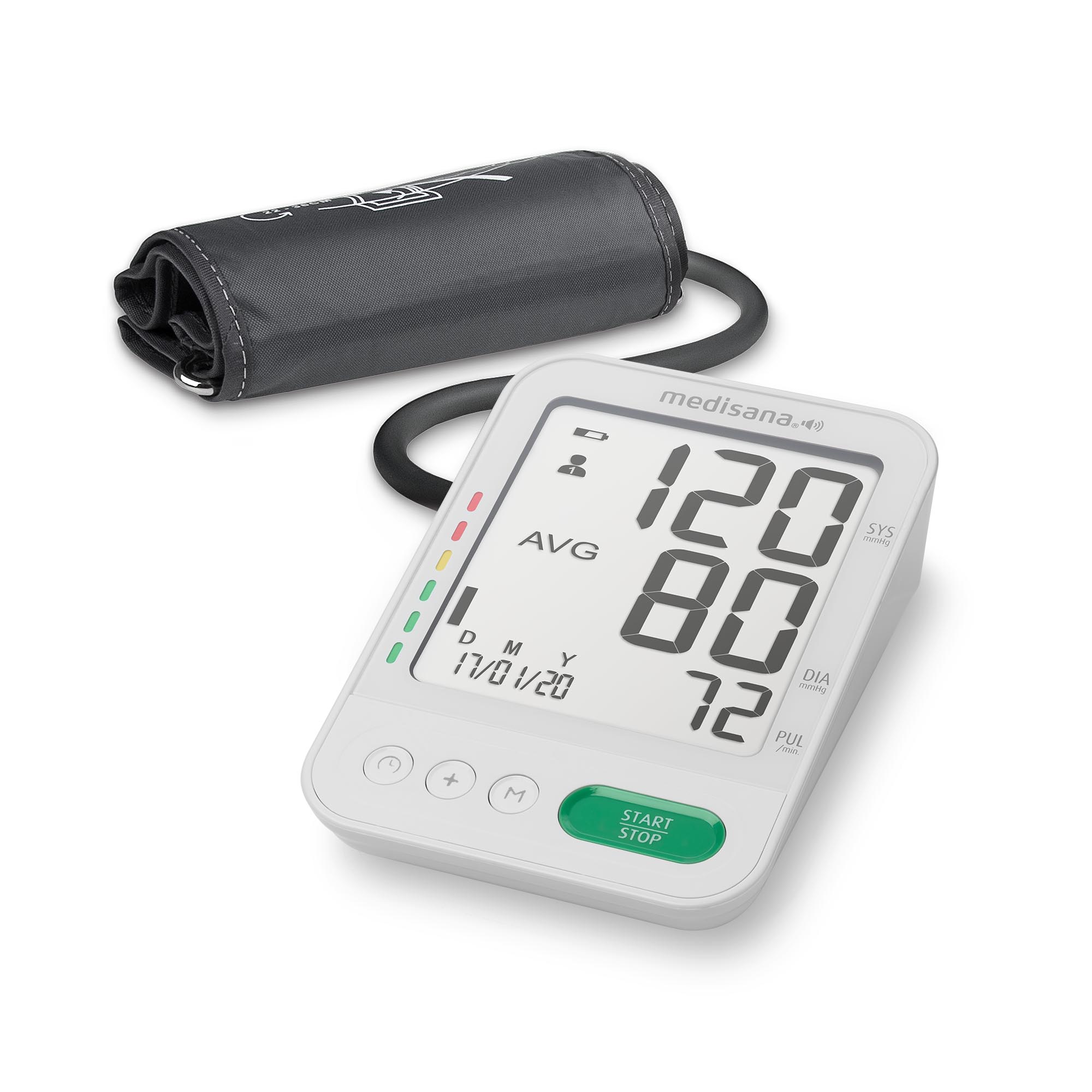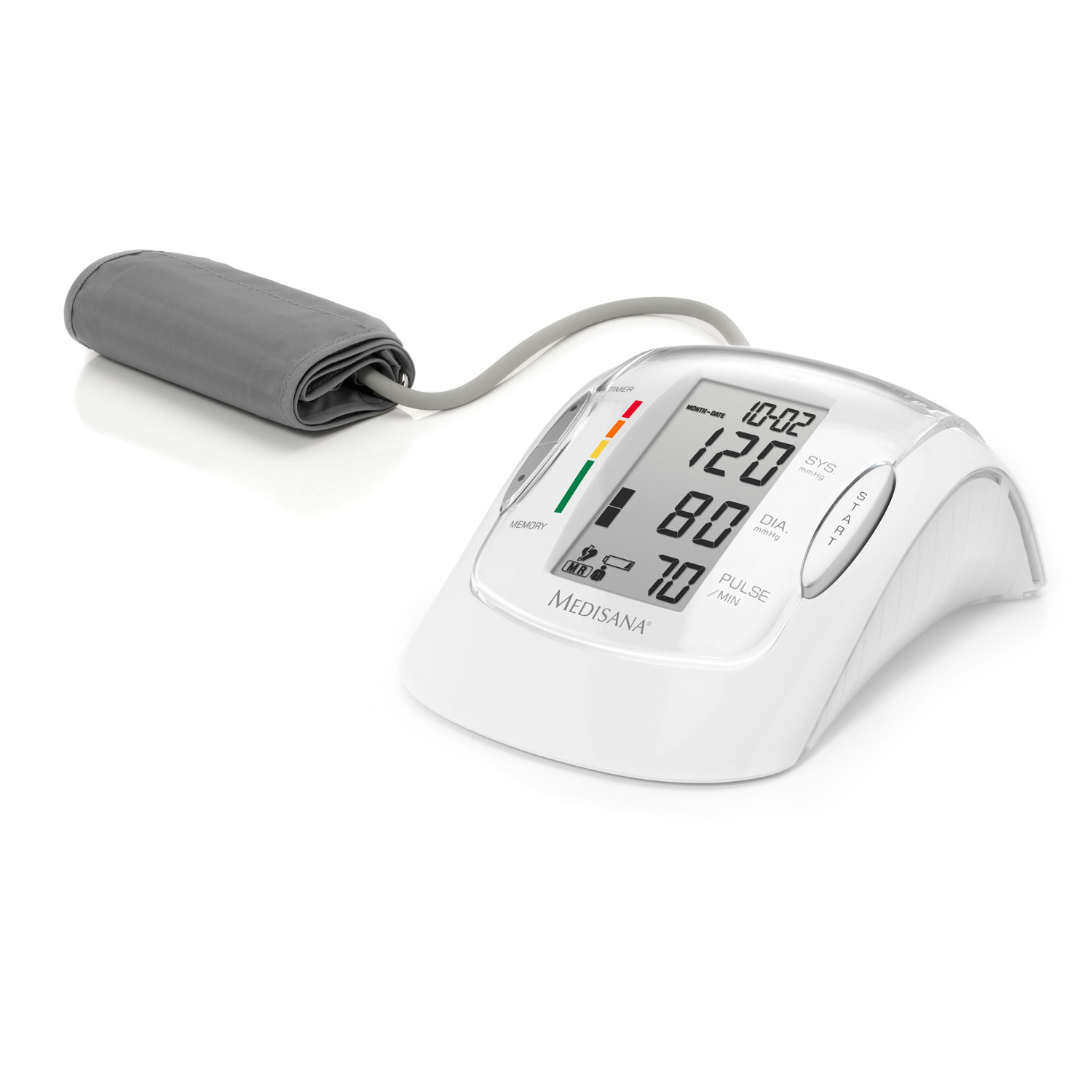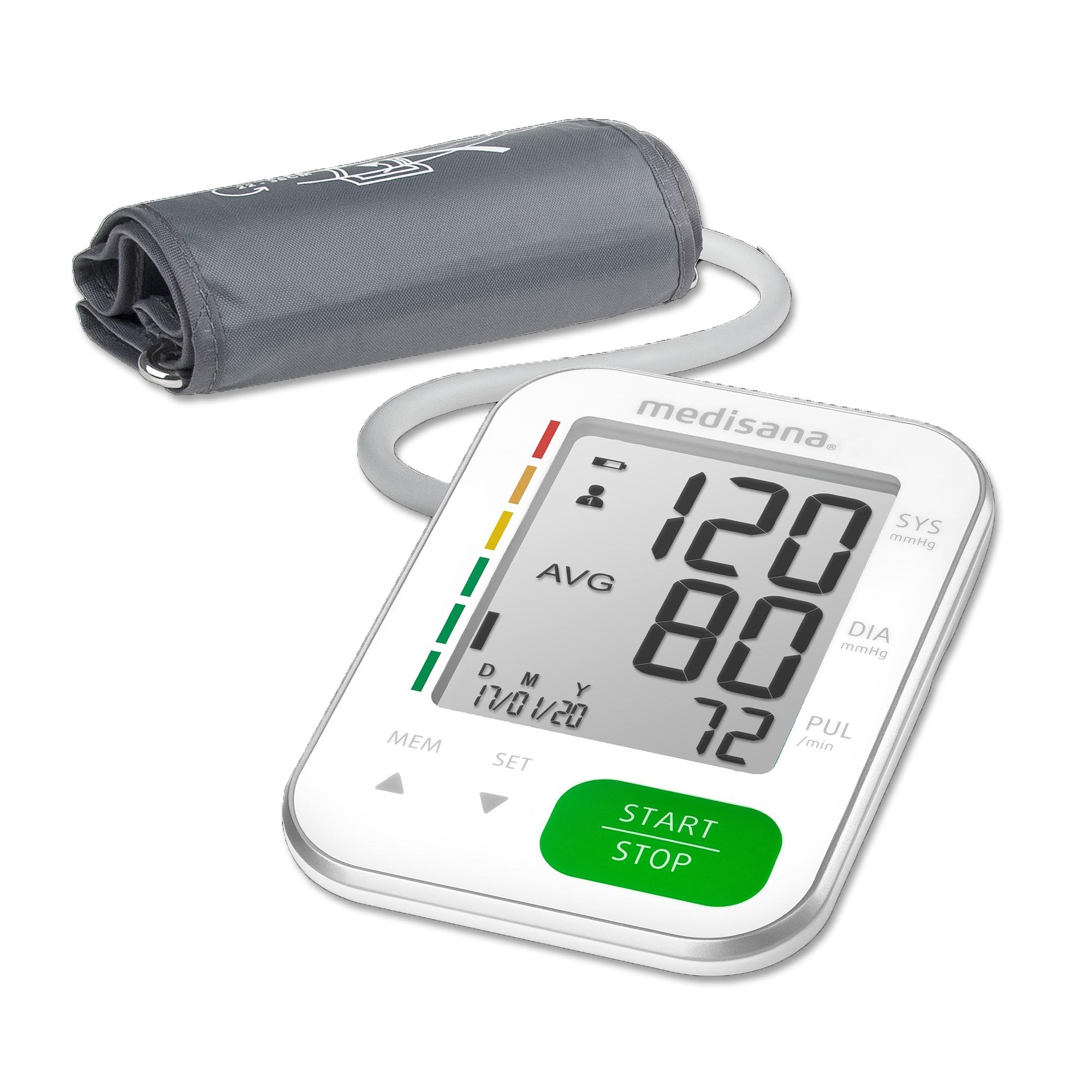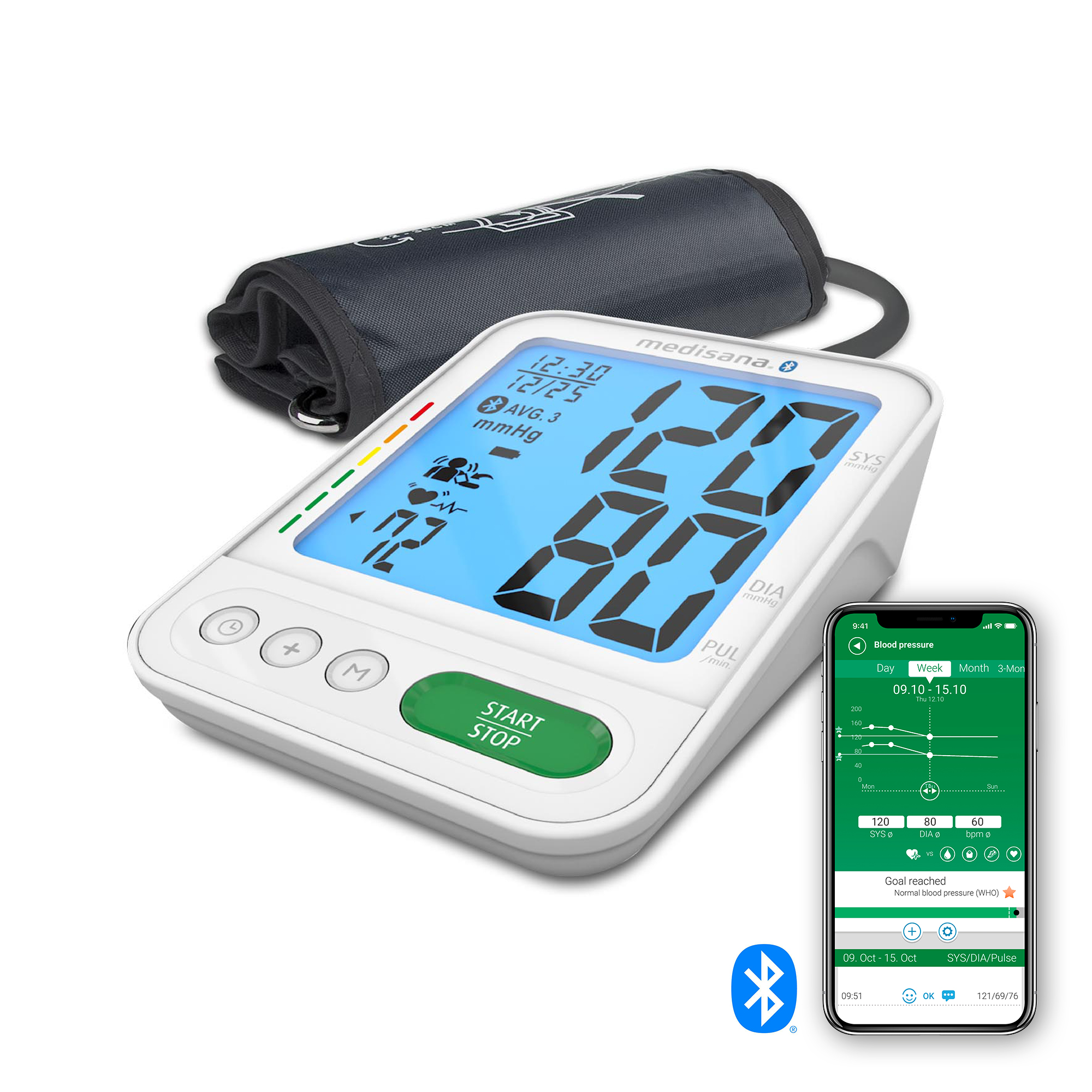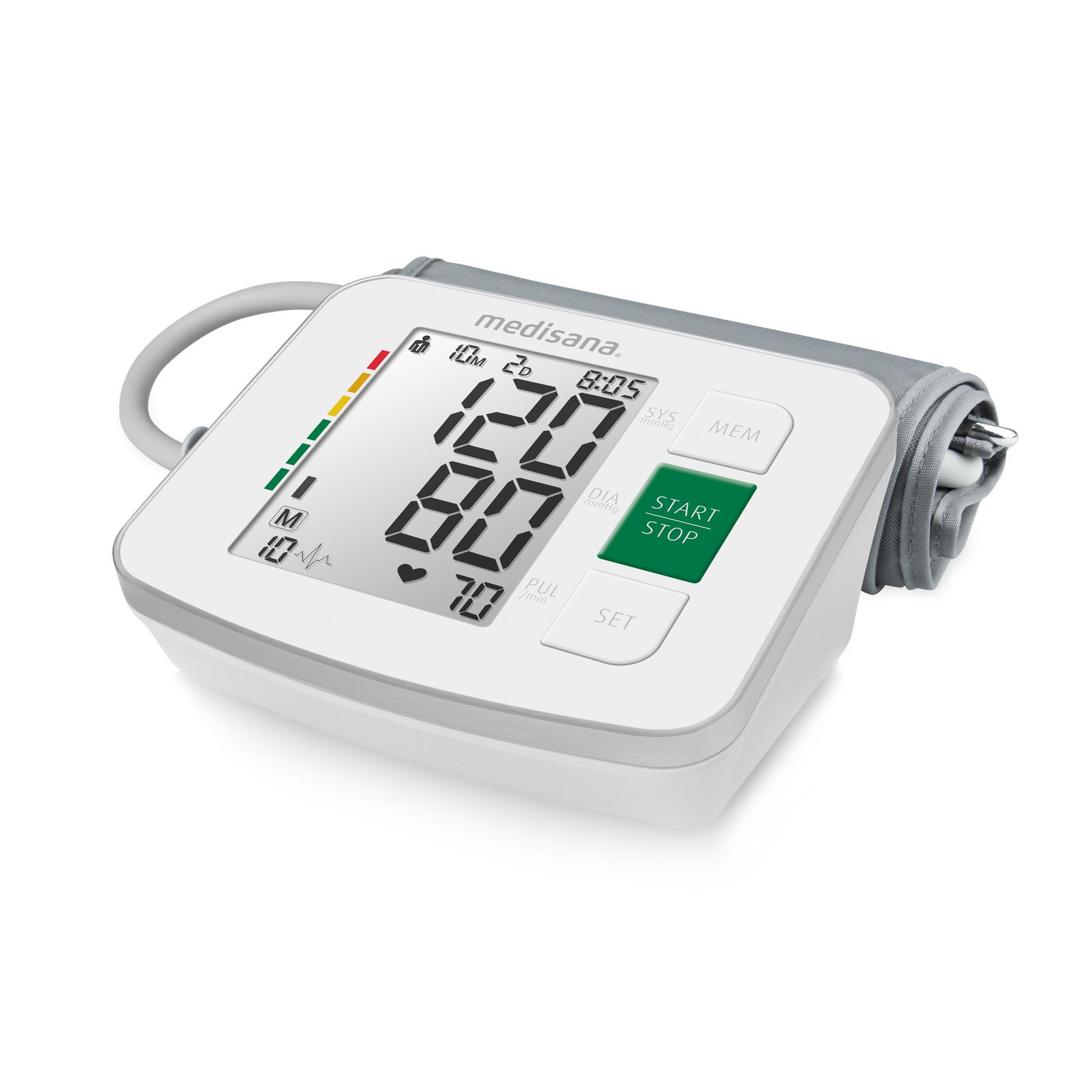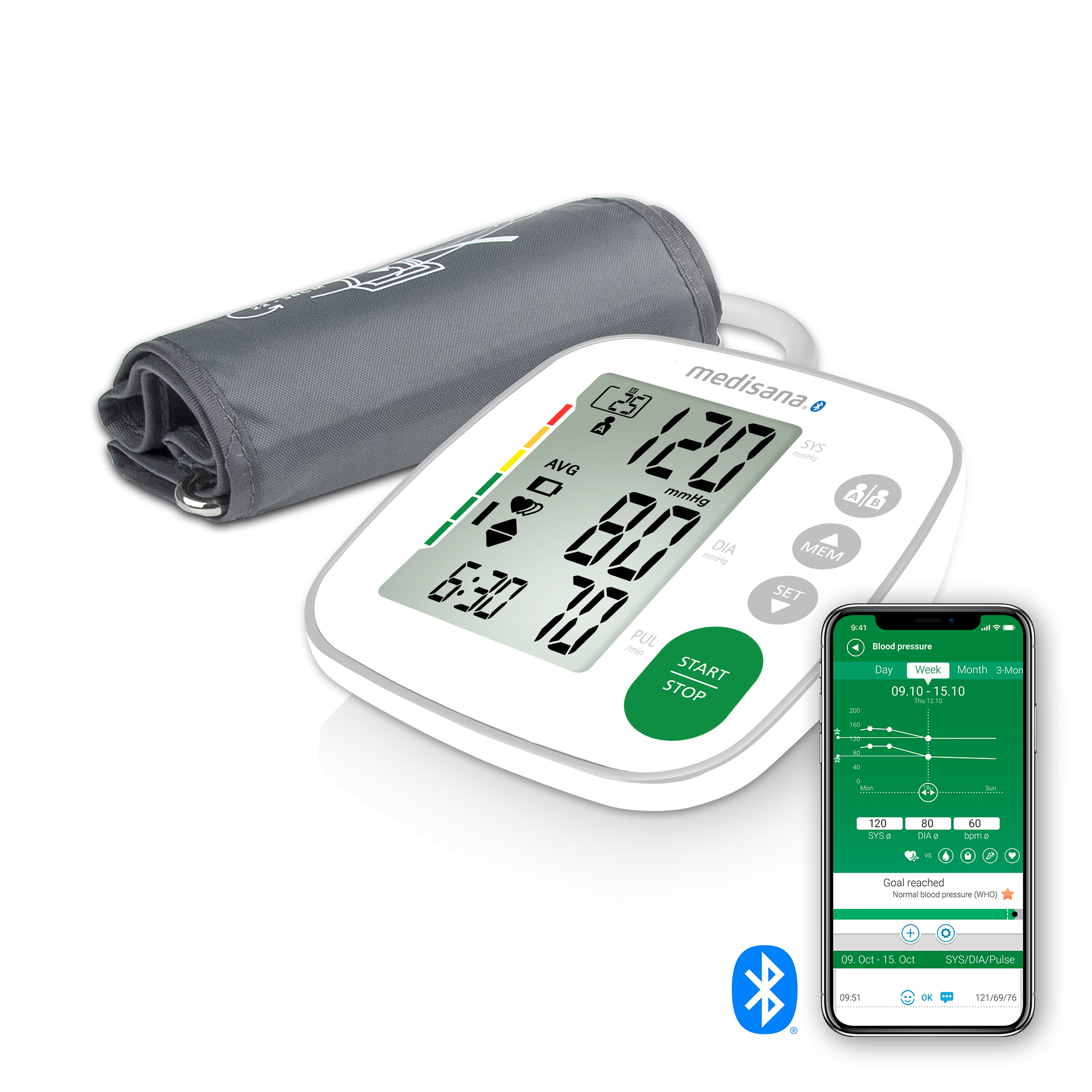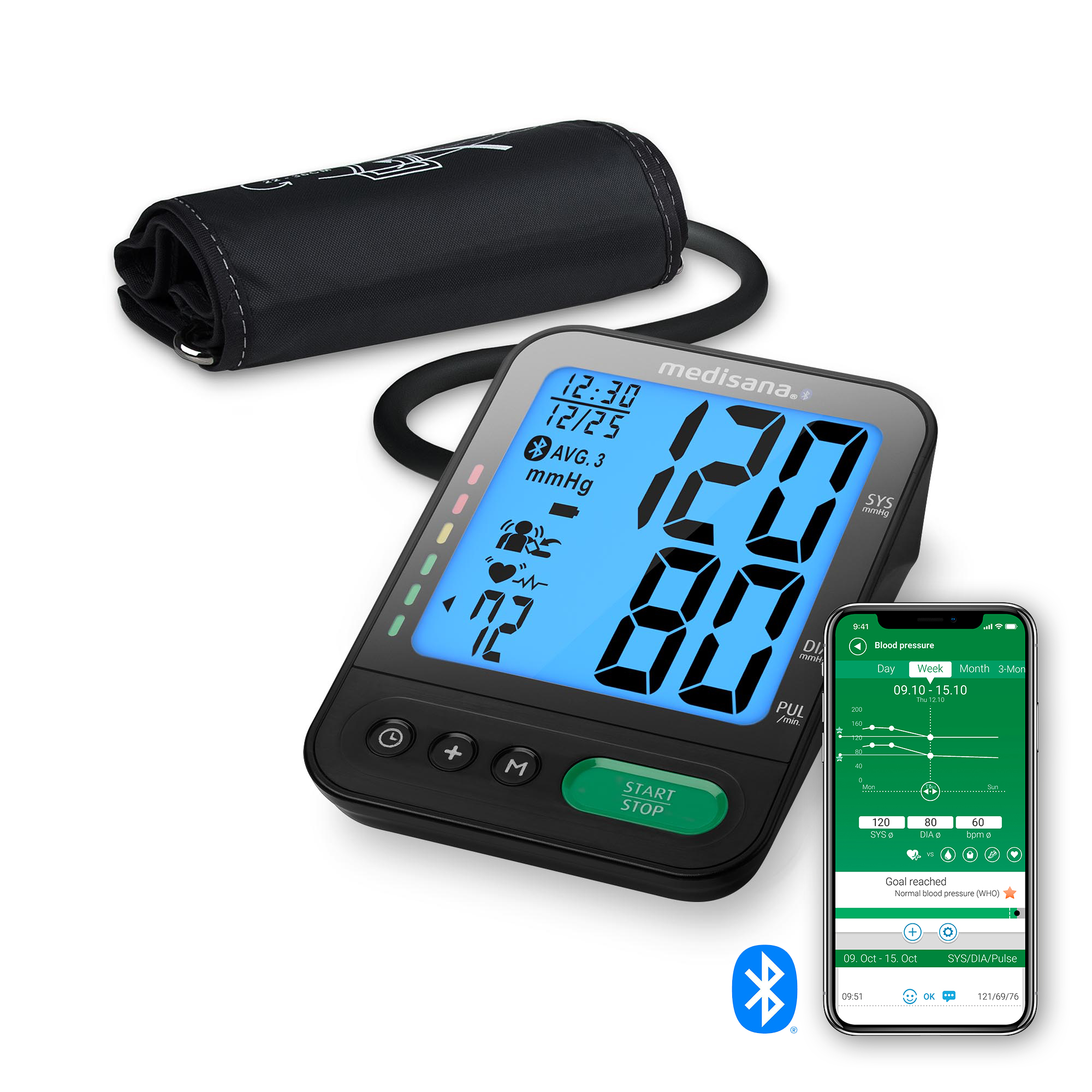BU 572 connect | Upper arm blood pressure monitor
Precise blood pressure measurement with modern technology Upper arm blood pressure monitor BU 572 connect combines modern technology with proven quality as a certified medical device (MDR). Compact and slim, it is ideal for storage and travel. Inflation technology ensures fast measurement, while the large backlit LCD clearly displays all values. Results can be conveniently transferred via Bluetooth® to the VitaDock+ app. Faster results with inflation technology The inflation technology measures blood pressure during cuff inflation and delivers faster results. This method saves time and provides comfort. The movement indicator and cuff fit control ensure accuracy. In addition, the device calculates the average of the last three results to give a meaningful overview of blood pressure trends. Clear XXL display with backlight The large LCD display (7.3 × 6.0 cm) with backlight clearly shows blood pressure and pulse values for easy reading. The traffic-light scale classification helps interpret results at a glance. An irregular heartbeat display adds transparency and safety during each measurement. Bluetooth® transfer to the VitaDock+ app With 199 memory slots for two users plus guest mode, BU 572 connect supports long-term documentation. Values can be transferred via Bluetooth® to the VitaDock+ app (iOS/Android) or VitaDock® Online to track trends and share data with healthcare professionals when needed. Product highlights at a glance: Accurate upper arm blood pressure measurement with traffic-light scaleInflation technology for fast and comfortable resultsLarge LCD display (7.3 × 6.0 cm) with backlightBluetooth® transfer to VitaDock+ app (iOS/Android)199 memory slots each for 2 users + guest modeIrregular heartbeat display for more safetyMovement indicator and cuff fit control for accurate measurementBattery or mains operation (Compatible with USB power adapters)Certified medical device (MDR) Technical data: Size: approx. 9.4 × 13.1 × 3.2 cmWeight: approx. 186 g (without cuff or batteries)Power supply: 4 × 1.5 V batteries (AAA) or 5 V 1 A USB-C cableMeasuring range: Blood pressure: 0–299 mmHg | Pulse: 40–199 beats/minuteAccuracy: Blood pressure: ± 3 mmHg | Pulse: ± 5 % of reading (at 5 °C–40 °C)Tube length: 80 cm
BU 570 connect | Upper Arm Blood Pressure Monitor
Faster measurement results thanks to inflating technologyThe BU 570 connect upper arm blood pressure monitor from medisana offers faster measurement results thanks to its innovative inflating technology, which measures the blood pressure while the cuff is being inflated. The function for recognising irregular heartbeats, the so-called IHB function, supplements the functions for precise blood pressure measurement on the upper arm.Ultra slim design in practical pocket formatThanks to its handy size, the BU 570 connect upper arm blood pressure monitor is not only convenient to use at home, but is also a practical companion when travelling. Thanks to state-of-the-art micro-components, its particularly flat design is just the size of three smartphones stacked on top of each other. Compact, space-saving and suitable for transport in almost any handbag!Data transfer to the VitaDock+ appA very practical feature of the BU 570 connect upper arm blood pressure monitor from medisana is that you can call up your vital data anytime and anywhere. This is because the Bluetooth Smart data transfer to the VitaDock+ App 2.0 for iOS and Android and to VitaDock Online allows you to analyse and evaluate the results. The upper arm blood pressure monitor also impresses with its 120 memory locations for two users and the calculation of the average value of the last three stored values.Technical dataSize: approx. 9.26 x 12.95 x 3.03 cm; Weight: approx. 0.188 kg4 x AAA batteries; output power: 6 VMeasuring pressure: SYS: 60mmHg~230mmHg DIA: 40mmHg~130mmHgMeasuring range: Nominal cuff pressure: 0mmHg~299mmHgPulse value: (40-199) beats/minute; Cable length: 60cm
BU 510 | Upper arm blood pressure monitor
Fast and precise blood pressure measurement on the upper armThe BU 510 upper arm blood pressure monitor from medisana is ideal for quick and precise blood pressure measurement on the upper arm and is a reliable aid for regular blood pressure monitoring. The medical device offers two users 90 memory locations each for the measured values. Its clear, easy-to-read display and an extra-large upper arm cuff for an arm circumference of 22 to 36 cm make it effortless to use.Easy to read thanks to large digitsThe BU 510 from Medisana impresses with its uncomplicated handling. The digital display informs you of the date, time, pulse, systole and diastole at a glance. The current measured values are evaluated using a traffic light colour scale. If required, the device can calculate an average value of all stored measurements. The BU 510 upper arm blood pressure monitor from medisana also has a display that can indicate an irregular heartbeat.Meaningful blood pressure monitoring for two usersThe BU 510 from Medisana is ideal for daily blood pressure monitoring and can be used by two people at the same time. Each user has 90 memory locations at their disposal. This not only provides you with a meaningful average value, but also allows you to call up the values of the last 90 measurements. The upper arm cuff supplied ensures precise and reliable readings even with a large upper arm circumference.Technical dataSize: approx. 13 x 11 x 6 cmWeight: approx. 0.30 kgMeasuring method: OscillometricMeasuring range: blood pressure 0-299 mmHg; pulse 40-199 beats/min.Batteries: 4x 1.5 V (AA)
BU 516 | Upper Arm Blood Pressure Monitor
With irregular heartbeat indicatorThe BU 516 upper arm blood pressure monitor from Medisana is a medical device that stands for precise blood pressure measurement on the upper arm. Its display shows systole, diastole, pulse, date and time as well as an arrhythmia indicator. In addition to the individual measured values, you can also calculate the average value of all stored data.Extra large digitsThanks to its particularly large illuminated digits of up to 22 millimetres in height, the Medisana BU 516 upper arm blood pressure monitor ensures optimum legibility. The extra-large cuff makes it possible to use the blood pressure monitor even with an arm circumference of up to 36 centimetres.Classification of the measured values using a traffic light colour scaleThe Medisana BU 516 upper arm blood pressure monitor uses a traffic light colour scale to classify the measured values. The blood pressure monitor has 90 memory locations for two users. You can choose to use it in mains or battery operation.Technical dataSize: approx. 13 × 11 × 6 cmWeight: approx. 0.30 kgMeasuring method: OscillometricMeasuring range: Blood pressure: 0 - 299 mmHg Pulse: 40 - 199 beats/min.Batteries: 4 × 1.5 V (AA)
BU 535 Voice | Upper arm blood pressure monitor
With voice outputThe special feature: You can select a voice output in your national language. You can choose from German, English, Dutch, French, Italian and Turkish.Particularly large digitsThanks to its particularly large digits, the medisana BU 535 Voice upper arm blood pressure monitor ensures optimum legibility.Classification of measured values according to traffic light colour scaleYou can also have the average value of the last three stored readings calculated if you wish. The blood pressure monitor has 120 memory locations for two users.Technical dataSize: approx. 15 × 9.5 × 4.1 cmWeight: approx. 0.23 kgMeasuring method: OscillometricMeasuring range: Blood pressure: 40-260 mmHg | Pulse: 40-180 beats/min.Batteries: 4 × 1.5 V (AA)
BU 582 | Upper arm blood pressure monitor
Note on application errorsThe medisana BU 582 upper arm blood pressure monitor guarantees faster measurement results thanks to the innovative inflation technology, which measures the blood pressure while the cuff is being inflated. Highly reliable: if you as the user make any errors, the device automatically gives you a warning. The certified medical device also has a function for precise blood pressure measurement on the upper arm, the so-called IHB function, which recognises irregular heartbeats.Integrated motion sensor to ensure accurate measurement resultsAn integrated motion sensor in the medisana upper arm blood pressure monitor BU 582 is responsible for ensuring accurate measurement results. The blood pressure results are then classified by grading the measured values using a traffic light colour scale.Elegant design in blackDo you want a mix of precise blood pressure measurement and an attractive design? Then the medisana BU 582 upper arm blood pressure monitor is the right choice for you, as its elegant black design offers optimum readability thanks to its large LCD display with extra-large 40 millimetre digits. Two users can choose from 120 memory locations. Its upper arm cuff is particularly large with an arm circumference of 23 to 43 centimetres.Technical dataSize: approx. 13.7 × 9.85 × 5.25 cm; weight: approx. 0.30 kgMeasuring method: OscillometricMeasuring range: Blood pressure: 40 - 280 mmHgMeasuring range: Pulse: 40 - 199 beats/minBatteries: 4 × 1.5V (AAA)
BU 586 Voice | Upper arm blood pressure monitor
Voice output in six different languagesThe BU 586 Voice upper arm blood pressure monitor from medisana is a certified medical device for precise blood pressure measurement on the upper arm. Thanks to its inflating technology, it can deliver faster measurement results. Its integrated motion sensor ensures accurate measurement results. The special feature: You can select a voice output in the respective national language. You can choose from German, English, Dutch, French, Italian and TurkishElegant, classic design including large LCD displayThe medisana BU 586 Voice upper arm blood pressure monitor also impresses with its elegant, classic design including a large LCD display with extra-large 40 millimetre digits. This ensures optimum readability at all times. The extra-large upper arm cuff makes it possible to use the BU 586 Voice upper arm blood pressure monitor with an arm circumference of 23 to 43 centimetres. There are 120 memory locations available for two users.Blood pressure classificationThe medisana BU 586 Voice upper arm blood pressure monitor classifies blood pressure by grading the measured values using a traffic light colour scale in green, orange and red. An indication of irregular heartbeat, the so-called IHB function, as well as an indication of application errors round off the practical functions.Technical dataSize: approx. 13.7 × 9.85 × 5.25 cm; weight: approx. 0.30 kgMeasuring method: OscillometricMeasuring range: Blood pressure: 40 - 280 mmHgMeasuring range: Pulse: 40 - 199 beats/minBatteries: 4 × 1.5V (AAA)
MTP Pro | Upper arm blood pressure monitor
Simple health monitoring from homeWith the excellent blood pressure monitors from medisana, you can check your readings easily, quickly and safely. The top-selling MTP Pro offers everything you need for reliable blood pressure measurement. The medical device has 99 memory slots for two users and an average value calculation function allows you to keep a constant eye on your blood pressure, giving you peace of mind. The large, easy-to-read display is particularly practical.High qualityBy regularly measuring your blood pressure yourself, you and your doctor receive important information about your state of health. One argument in favour of measuring blood pressure at home is the fact that the measurement is carried out in familiar surroundings and under relaxed conditions. The so-called baseline value, which is measured in the morning directly after getting up and before breakfast, is particularly meaningful. The MTP Pro stands for precise blood pressure measurement on the upper arm.Traffic light colour scale and display of irregular heartbeatThe MTP Pro offers two new additional features: The classification of the measured values using the clear traffic light colour scale and the display of irregular heartbeats. The measured values systole, diastole, pulse, date and time are clearly shown on the display and automatically saved in the device so that they can be called up again at any time.Technical dataSize: approx. 12 × 16.3 × 6.6 cm; Weight: approx. 0.5 kg incl. batteriesMeasuring method: OscillometricMeasuring range: Blood pressure: 30-280 mmHgPulse: 40-200 beats/min.Batteries: 4 × 1.5 V (AA)
BU 565 | Upper arm blood pressure monitor
Faster measurement results thanks to inflating technologyThe BU 565 upper arm blood pressure monitor from medisana offers faster measurement results thanks to its innovative inflating technology, which measures the blood pressure while the cuff is being inflated. The function for detecting irregular heartbeats, the so-called IHB function, complements the functions for precise blood pressure measurement on the upper arm.Ultra slim design in practical pocket formatThanks to its handy size, the BU 565 upper arm blood pressure monitor is not only convenient to use at home, but is also a practical companion when travelling. Thanks to state-of-the-art micro-components, its particularly flat design is just the size of three smartphones stacked on top of each other. Compact, space-saving and suitable for carrying in almost any handbag!Particularly large, easy-to-read displayThe medisana BU 565 white upper arm blood pressure monitor offers optimum readability thanks to its particularly large, easy-to-read display. The LCD display measures 73 x 60 millimetres and has a practical backlight. The BU 565 white upper arm blood pressure monitor offers two users 120 memory locations each. The average value can be calculated from the last three stored values.Technical dataSize: approx. 9.26 x 12.95 x 3.03 cm; Weight: approx. 0.188 kg4 x AAA batteries; output power: 6 VMeasuring pressure: SYS: 60mmHg~230mmHg DIA: 40mmHg~130mmHgMeasuring range: Nominal cuff pressure: 0mmHg~299mmHgPulse value: (40-199) beats/minute; Cable length: 60cm
BU 584 connect | Upper arm blood pressure monitor
Large LCD display with blue backlighting and extra-large digitsThe medisana BU 584 connect upper arm blood pressure monitor with its elegant design is impressive thanks to its large LCD display with blue backlighting and extra-large digits measuring 40 millimetres. This certified medical device uses a traffic light colour scale to classify the measured values. The BU 584 connect upper arm blood pressure monitor also impresses with its 120 memory slots for two users and its particularly large upper arm cuff.Faster measurement results thanks to inflation technologyThe medisana BU 584 connect upper arm blood pressure monitor can deliver faster measurement results thanks to its inflating technology, which measures the blood pressure while the cuff is being inflated. An integrated motion sensor is responsible for ensuring accurate measurement results. The function for recognising irregular heartbeats, the so-called IHB function, as well as an indication of application errors round off the innovative functions for precise blood pressure measurement.Bluetooth data transmission to the VitaDock+ app and VitaDock OnlineA particularly practical feature of the BU 584 connect upper arm blood pressure monitor from medisana is that you always have your vital data with you, wherever you are. With the help of Bluetooth Smart data transfer to the VitaDock+ App 2.0 for iOS and Android and to VitaDock Online, the results can be easily analysed and evaluated at any time or shown directly to the doctor.Technical dataSize: approx. 13.7 × 9.85 × 5.25 cm; weight: approx. 0.30 kgMeasuring method: OscillometricMeasuring range: Blood pressure: 40 - 280 mmHgMeasuring range: Pulse: 40 - 199 beats/minBatteries: 4 × 1.5V (AAA)
BU 535 Voice | Upper arm blood pressure monitor | International version
With voice outputThe special feature: You can select a voice output in your national language. You can choose from English, French, Russian, Spanish, Greek and Arabic.Particularly large digitsThanks to its particularly large digits, the medisana BU 535 Voice upper arm blood pressure monitor ensures optimum legibility.Classification of measured values according to traffic light colour scaleYou can also have the average value of the last three stored readings calculated if you wish. The blood pressure monitor has 120 memory locations for two users.Technical dataSize: approx. 15 × 9.5 × 4.1 cmWeight: approx. 0.23 kgMeasuring method: OscillometricMeasuring range: Blood pressure: 40-260 mmHg | Pulse: 40-180 beats/min.Batteries: 4 × 1.5 V (AA)
BU 512 | Upper arm blood pressure monitor
Easy to read thanks to large digitsThe BU 512 from medisana impresses with its uncomplicated handling. The digital display informs you of the date, time, pulse, systole and diastole at a glance. The current measured values are evaluated using a traffic light colour scale. If required, the device can calculate an average value of all stored measurements. The BU 512 upper arm blood pressure monitor from medisana also has a display that can indicate an irregular heartbeat.Meaningful blood pressure monitoring for two usersThe BU 512 from medisana is ideal for daily blood pressure monitoring and can be used by two people at the same time. Each user has 90 memory locations at their disposal. The upper arm cuff supplied ensures precise and reliable readings even with a large upper arm circumference. If the enclosed cuff is not sufficient for an arm circumference of 22 to 36 cm, an extra-large cuff for an arm circumference of 32 to 42 cm is available as an optional accessory.Technical dataSize: approx. 13 x 11 x 6 cmWeight: approx. 0.30 kgMeasuring method: OscillometricMeasuring range: Blood pressure 0-299 mmHg; pulse 40-199 beats/min.Batteries: 4x 1.5 V (AA)
BU A52 connect | Upper arm blood pressure monitor
Simple health monitoring from homeThe BU A52 connect upper arm blood pressure monitor from medisana is a certified medical device and offers you precise blood pressure measurement on the upper arm. The device shows the blood pressure classification and classification of the measured values with the help of the intuitively understandable traffic light colour scale. As the BU A52 connect upper arm blood pressure monitor has a helpful display for irregular heartbeats, the so-called IHB function, you are informed immediately of any irregularities.Precise blood pressure measurement on the upper armThe medisana BU A52 connect upper arm blood pressure monitor stands for precise blood pressure measurement on the upper arm. The blood pressure classification and classification of the measured values is carried out with the certified medical device using the intuitively understandable traffic light colour scale. The BU A52 connect upper arm blood pressure monitor also impresses with its particularly large upper arm cuff for an arm circumference of 22 to 42 centimetres.Display of irregular heartbeatThe medisana BU A52 connect upper arm blood pressure monitor is equipped with a helpful irregular heartbeat indicator, the so-called IHB function. This means you are informed of irregularities at a glance. Its particularly large, easy-to-read display makes it very easy for you to recognise the relevant data. The display shows systole, diastole, pulse, date and time.Technical dataSize: approx. 140 × 140 × 60 mmWeight: approx. 250 gMeasuring method: oscillometricMeasuring range:- Blood pressure: 40-230 mmHg- Pulse: 40-199 beats/min.Batteries: 4 × 1.5 V (AAA)
BU A57 | Upper arm blood pressure monitor
Simple health monitoring from homeThe BU A57 upper arm blood pressure monitor from medisana offers you precise blood pressure measurement on the upper arm. As a certified medical device, it is subject to the guidelines of the MDD Medical Device Directive. The device uses a colour scale to make a diagnosis and its display provides information on systole, diastole, heart rate, date and the current time. A practical feature is that it calculates the average of all measurements.Precise blood pressure measurement on the upper armThe medisana BU A57 upper arm blood pressure monitor offers you precise blood pressure measurement on the upper arm. Its display provides you with information on systole, diastole, heart rate, date and the current time. In addition, the BU A57 upper arm blood pressure monitor with its large cuff for an arm circumference of 22 to 36 centimetres has a helpful display for irregular heartbeats.Medically certified blood pressure monitorThe BU A57 upper arm blood pressure monitor from medisana, one of the leading specialists in the home health care market, is a certified medical device that is subject to the guidelines of the MDD Medical Device Directive. The device makes the diagnosis using a colour scale.Technical dataSize: approx. 150 × 95 × 41 mmWeight: approx. 225 gMeasuring method: oscillometricMeasuring range: blood pressure: 40-230 mmHg; pulse: 40-199 beats/min.Batteries: 4 × 1.5 V (AAA)
BU 580 connect | Upper arm blood pressure monitor
Large LCD display with blue backlighting and extra-large digitsThe medisana BU 580 connect upper arm blood pressure monitor is impressive thanks to its large LCD display with blue backlighting and extra-large digits measuring 40 millimetres. This certified medical device uses a traffic light colour scale to classify the measured values. The BU 580 connect upper arm blood pressure monitor also impresses with its 120 memory slots for two users and its particularly large upper arm cuff for an arm circumference of 23 to 43 centimetres.Faster measurement results thanks to inflating technologyThe medisana BU 580 connect upper arm blood pressure monitor can deliver faster measurement results thanks to its inflating technology, which measures the blood pressure while the cuff is being inflated. An integrated motion sensor is responsible for ensuring accurate measurement results. The function for recognising irregular heartbeats, the so-called IHB function, as well as an indication of application errors round off the innovative functions for precise blood measurement.Bluetooth data transfer to the VitaDock+ app and VitaDock OnlineA particularly practical feature of the BU 580 connect upper arm blood pressure monitor from medisana is that you always have your vital data with you, wherever you are. With the help of Bluetooth Smart data transfer to the VitaDock+ App 2.0 for iOS and Android and to VitaDock Online, the results can be easily analysed and evaluated at any time or shown directly to the doctor.Technical specificationsSize: approx. 13.7 × 9.85 × 5.25 cm; weight: approx. 0.30 kgMeasuring method: OscillometricMeasuring range: Blood pressure: 40 - 280 mmHgMeasuring range: Pulse: 40 - 199 beats/minBatteries: 4 × 1.5V (AAA)
Upper Arm Blood Pressure Monitors by medisana – Ideal for At-Home Monitoring
Blood pressure can be measured using various methods. In most cases, indirect measurement is fully sufficient and commonly used both in medical settings and at home. That’s why upper arm blood pressure monitors are the most popular option for home use. They are easy to operate, deliver reliable results, and make it simple to follow standard recommendations for accurate measurement.
As an alternative, medisana also offers wrist monitors, which are just as precise but require more careful handling. All blood pressure monitors — whether for the upper arm or wrist — display values in mmHg (millimeters of mercury), the legally defined unit used throughout the European Union.
Advantages of Upper Arm Blood Pressure Monitors
Whether your blood pressure is within the normal range or not, fluctuations are always possible and usually harmless. If regular monitoring is required, however, it’s essential to follow certain guidelines to ensure consistent and accurate readings. Upper arm monitors provide an ideal basis for this. Blood pressure should always be taken while seated, in a calm environment, and after a short resting period. Most importantly, the cuff should be at heart level — something upper arm monitors ensure by design.
Wrist blood pressure monitors can also deliver accurate results if used correctly, but they often tempt users into less precise positioning. That said, they’re practical for travel and easy to store. In general, it’s important for users to understand how their device works and to allow the necessary calm and focus during the measurement — unless a quick check is urgently needed.
Factors That Influence Blood Pressure Readings
Blood pressure results — even with an upper arm device — can be affected by various external factors. Besides correct posture, a resting phase, and a quiet environment, it's also important to avoid speaking, smoking, or consuming caffeine before and during measurement. Other factors such as a full bladder, cold room temperature, or an improperly fitted cuff can also distort results.
If you need to measure your blood pressure regularly, it's a good idea to turn it into a daily habit or ritual. This might feel unfamiliar at first, but most people quickly adapt. A practical tip: during the short rest before starting your device, think about something pleasant and routine — for example, what you'll cook today or tomorrow. After measurement, your results can either be noted manually or stored digitally.
Connect models from medisana allow automatic Bluetooth transfer to the VitaDock+ app, where your readings are clearly displayed in graphs. With multiple user profiles available, digital tracking remains accurate even when the device is shared.


